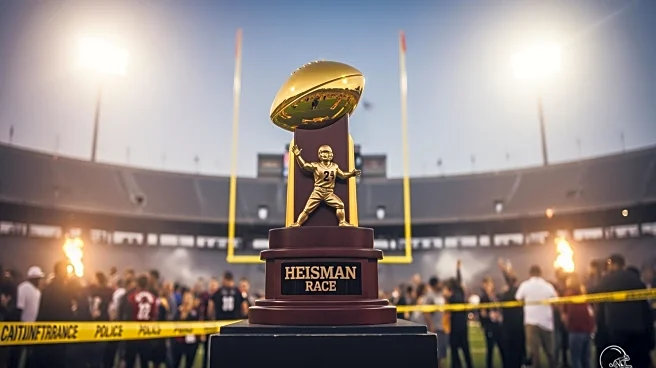What's Happening?
The Heisman Trophy race in college football has seen significant shifts as the season progresses, with eight different frontrunners emerging over eight weeks. Notable changes include Carson Beck's drop
after a four-interception game against Louisville, replaced by Julian Sayin following his impressive performance against Wisconsin. Fernando Mendoza of Indiana and Ty Simpson of Alabama remain steady in the top three, showcasing elite efficiency and composure. The race is characterized by volatility, with no clear favorite emerging, reflecting the unpredictable nature of the current college football season.
Why It's Important?
The Heisman Trophy is one of the most prestigious awards in college football, often influencing player careers and team dynamics. The frequent changes in frontrunners highlight the competitive nature of the season and the impact of individual performances on team success. This volatility can affect betting markets and fan engagement, as well as the strategic decisions of teams aiming to maximize their players' visibility and chances for the award. The evolving race underscores the importance of consistency and standout performances in securing a place among the nation's elite players.
What's Next?
As the season progresses, players like Julian Sayin and Ty Simpson will continue to be closely watched, especially in upcoming high-stakes games that could further alter the Heisman race. Teams will likely strategize to highlight their players' strengths, aiming for pivotal wins that could boost their candidates' chances. The race will continue to be a focal point for analysts and fans, with potential implications for team rankings and playoff considerations. The upcoming games will be crucial in determining who emerges as the definitive frontrunner for the Heisman Trophy.
Beyond the Headlines
The Heisman race not only affects individual players but also has broader implications for college football programs. Success in the race can enhance a program's reputation, attract recruits, and increase media attention. The dynamics of the race reflect broader trends in college football, such as the increasing importance of quarterback performance and the strategic emphasis on offensive efficiency. The race also highlights the role of media narratives and public perception in shaping the outcomes of prestigious awards.














